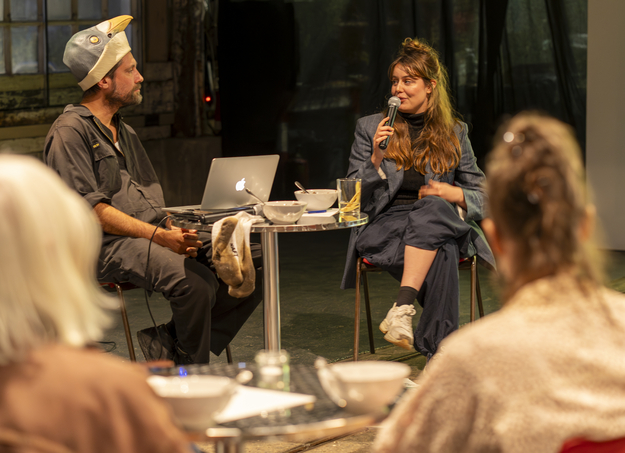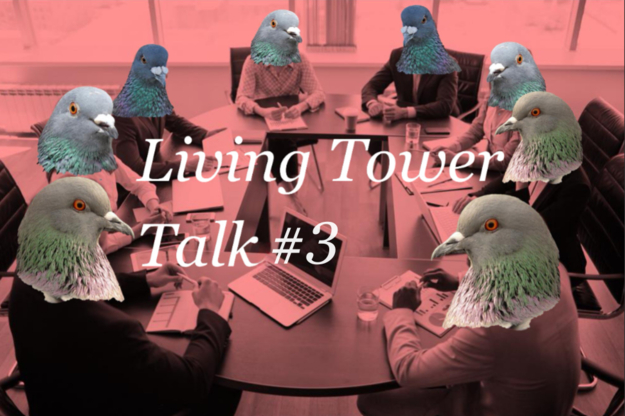Gentle Disco, which is the prelude to the Living Tower Talk series, introduces participants to a world where mycelium, the underground network of fungal threads, becomes the dancefloor. It is a dance with mycelium, an invitation to breathe life into the living towers, and a joyful celebration of nature’s rhythms. Attendees take part in an avant-garde dance party that fuses human movement with the natural world. This unusual dance is more than just entertainment; it is a living experiment in coexistence and collaboration with mycelium. As dancers sway and twirl, they help to infuse life into the mycelium, contributing to a delicate and ever-evolving ecosystem as well as encouraging a playful relationship between humans and nature.
“It works, and at the same time, it turns into culture”
Arne Hendriks, the mind behind the mycelium-waste pigeon towers, kicked off the event by introducing his unique architectural project. These pigeon towers represent a fascinating blend of art and ecology. Arne shared how pigeon towers have been used historically and showed examples, including Iranian pigeon towers, which function as industrial machines for fertilizer production. Arne's project is not just about building structures but also about forming a profound connection with the living material. He emphasized the transformative power of his work, stating, "It works, and at the same time, it turns into culture." This approach to architecture challenges the traditional boundaries between nature and culture, opening new avenues for exploration.
Arne's project serves as an excellent segue to Anne Hofstra's unconventional adventure in which she invited chickens to be the audience during the theater performance, KIP. Anne's performance, which brought together chickens and humans in a shared theatrical experience, challenges the boundaries of inclusivity beyond species. Her project serves as an artistic project rooted in ecocentrism - reconsidering our decisions and policies concerning the whole ecosystem.
Anne embarked on her journey with a singular focus on chickens. Her research revealed that while chickens have been profoundly shaped by the food industry, they possess remarkable cognitive abilities. They can count, reason logically, dream, and even imagine. Anne’x six-week immersion with 40 chickens involved an array of sensory experiences, from music and dance to playful interactions. However, it quickly became evident that understanding and interpreting chicken behavior was a complex puzzle. Anne grappled with the realization that she could never fully comprehend what it's like to be a chicken. Yet, her commitment to empathetic decision-making and the benefit of the doubt led her to believe that the effort was worthwhile. Chickens had the autonomy to participate or leave the performance, a testament to respecting their agency. During the conversation, Anne and Arne pondered the challenges of making decisions for non-human entities. Arne highlighted the importance of radical imagination and curiosity in shaping our relationship with the environment. While Anne initially believed she could decipher whether chickens enjoyed art, she ultimately accepted the limits of human understanding. The theme of respecting the unknown and embracing uncertainty resonated with Arne's project as well. Arne emphasized the power of life's magnetic force and how living materials, unlike concrete, exhibit their own behaviors and ecological complexity. These materials invite life, nurturing an entire ecosystem that includes worms, ants, and plants—a beautiful example of circularity.
The conversation opened up, when Clemens Driessen posed a question, drawing from Anne’s reflection on her project as “really beautiful and really pathetic at the same time.” He asked Anne, “Do you think you need to be pathetic to become ecocentric, or did it feel like a failure?” Anne admitted that there were moments when she grappled with feelings of vulnerability, a sense of failing, and the ever-present temptation to give up. It was an acknowledgment that thinking ecocentrically isn't always a straightforward path, and it can be fraught with challenges and uncertainties. There was also some criticism and contemplation, notably from the audience, on whether it was ethical to bring chickens into human spaces and potentially make them dependent. Anne acknowledged her project's limitations but maintained that there was still value in the experiment, a sentiment echoed by Arne.
As we continue to explore the intersection of art, nature, and the human spirit, we are reminded that the path to ecocentrism is marked by vulnerability, humility, and an unwavering commitment to nurturing timeless knowledge. So, let us be inspired by this discourse and carry it forward, fostering a deeper understanding of our place in the world and a profound connection with the environment that surrounds us. A world where critical thinking meets playful exploration, where ethics guide our actions, and where the whole ecosystem is held in high regard.

